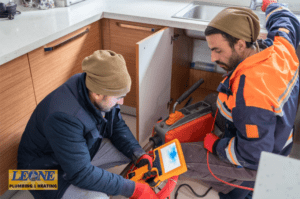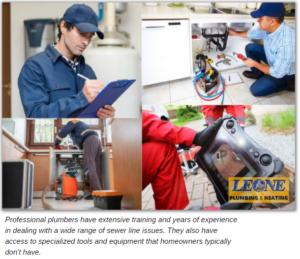How to Know If You Need a Sewer Line Inspection
 When it comes to your home, few things are as crucial as a functioning sewer line. A smooth-running sewer system ensures your plumbing operates seamlessly, but ignoring potential issues could lead to costly repairs and major inconveniences. There are undeniable warning signs that indicate you might need a sewer line inspection, and recognizing these red flags can save you time, money, and hassle down the line. From unpleasant odors wafting through your home to unusually lush patches of grass in your yard, these telltale signs shouldn’t be overlooked.
When it comes to your home, few things are as crucial as a functioning sewer line. A smooth-running sewer system ensures your plumbing operates seamlessly, but ignoring potential issues could lead to costly repairs and major inconveniences. There are undeniable warning signs that indicate you might need a sewer line inspection, and recognizing these red flags can save you time, money, and hassle down the line. From unpleasant odors wafting through your home to unusually lush patches of grass in your yard, these telltale signs shouldn’t be overlooked.
Why Regular Sewer Line Inspections Are Important
Regular sewer line inspections are crucial for maintaining a healthy and functional plumbing system in your home. A properly working sewer line efficiently removes wastewater, preventing potential health risks and property damage. Neglecting your sewer system can result in escalating issues that are costly and inconvenient. Routine inspections help catch minor problems early—such as small cracks or blockages—before they develop into major repairs like ruptures or severe clogs.
In addition to preventing structural damage, regular inspections also safeguard your household’s health. Sewer line issues can lead to water contamination and the spread of harmful bacteria, creating unsafe living conditions. Sewage backups and leaks pose serious health hazards, but proactive maintenance can keep these risks at bay. By scheduling regular checks, homeowners can ensure their sewer systems are in good condition and avoid both expensive repairs and potential health threats.
The Warning Signs That You Need a Sewer Line Inspection
Identifying warning signs can help you know when it’s time to schedule a sewer line inspection. Watch out for the symptoms and don’t ignore the red flags! Addressing the following warning signs early with a professional inspection can prevent more severe damage and costly repairs.Warning Sign 1: Unpleasant Odors
Foul odors in or around your home—ranging from musty smells to strong sewage-like stench—are a clear warning sign that you may need a sewer line inspection. These unpleasant smells often indicate a blockage, leak, or crack in the sewer line, which can allow harmful sewage gases to escape into your living space. Inhaling these gases poses health risks, including headaches, dizziness, and respiratory issues. Ignoring such odors can lead to serious problems like sewage backups and extensive property damage. Prompt professional inspection and maintenance can identify the source, prevent further complications, and ensure a safe, healthy home environment.Warning Sign 2: Slow Drains
Another critical warning sign that you need a sewer line inspection is slow drains. If you notice that your sinks, showers, or bathtubs are draining more slowly than usual, it could indicate a blockage or buildup in your sewer line. While it’s common for drains to slow down occasionally due to minor clogs, persistent slow drains throughout your home are a cause for concern.
Slow drains can be caused by various factors, including the accumulation of debris, grease, or foreign objects in the pipes. Over time, these materials can restrict the flow of wastewater, leading to slow drainage. In some cases, slow drains may also be a sign of tree root intrusion or pipe deterioration. Regardless of the cause, slow drains should not be ignored, as they can lead to more significant issues if left unaddressed.
Warning Sign 3: Frequent Clogs
Frequent clogs are a strong indication that there may be a deeper issue with your sewer line. While occasional clogs can typically be managed with a plunger or drain cleaner, recurring blockages—especially in multiple drains or toilets—suggest a more serious problem that requires professional attention. These persistent clogs can result from debris buildup, grease, foreign objects, or more severe issues like tree root intrusion or deteriorating pipes, all of which can significantly obstruct wastewater flow.
To prevent further damage, regular sewer line inspections are essential. Professional plumbers can use advanced tools such as video inspections and hydro-jetting to accurately diagnose and resolve the problem. Addressing frequent clogs early through these inspections helps avoid more serious complications like sewage backups and costly plumbing repairs, keeping your system functioning efficiently.
Warning Sign 4: Water Backups
Water backups are one of the most alarming warning signs that you need a sewer line inspection. If you notice water backing up into your sinks, toilets, or bathtubs, it’s a clear indication that there is a blockage or obstruction in your sewer line. Water backups can be caused by various factors, including clogs, tree root intrusion, or pipe damage.
When water backups occur, it’s essential to take immediate action. Water backups can lead to unsanitary conditions, as sewage and wastewater can contaminate your living spaces. This can pose serious health risks to you and your family, as well as cause extensive damage to your property. Regular sewer line inspections can help identify the source of the blockage and allow for prompt repairs, preventing further complications.
Warning Sign 5: Lush Patches in Your Yard
Unusually lush patches of grass in your yard can be an unexpected warning sign of a leaking sewer line. While a green lawn is typically desirable, sudden, isolated areas of excessive growth may indicate that nutrient-rich wastewater is seeping into the soil due to cracks, breaks, or tree root intrusion in the sewer line. This leakage acts as a fertilizer, promoting abnormal plant growth. If you notice these patches, it’s important to schedule a sewer line inspection to pinpoint and resolve the issue before it leads to more serious damage.
Warning Sign 6: Unexplained Increase in Water Bills
A sudden, unexplained spike in your water bills may be a sign of hidden leaks or other issues in your sewer line that require inspection. While normal usage can fluctuate, significant increases often point to problems like pipe deterioration, cracks, or tree root intrusion, causing water to leak continuously. These hidden leaks not only waste water and raise utility costs but can also lead to serious property damage, including soil erosion, foundation issues, and mold growth. Regular sewer line inspections can detect these problems early, allowing for timely repairs that protect your home, conserve water, and reduce expenses.What to Expect During a Professional Sewer Line Inspection
During a professional sewer line inspection, a plumber evaluates the plumbing system for signs of trouble like slow drains or foul odors, then uses a waterproof video inspection camera inserted through a cleanout access point to view the inside of the pipes in real time. This allows them to identify issues such as cracks, blockages, tree root intrusion, or corrosion without digging. Additional tools like hydro-jetting equipment may be used to clear blockages, while smoke or dye testing can help detect hidden leaks. After analyzing the findings, the plumber provides a detailed report with repair or maintenance recommendations, ensuring the sewer system stays efficient and problem-free.

Conclusion: Taking Action on Sewer Line Issues
Recognizing the warning signs that signal the need for a sewer line inspection is essential to keeping your home’s plumbing system running smoothly. Unpleasant odors, slow drains, frequent clogs, and water backups are all indicators that something may be wrong beneath the surface. Ignoring these issues can lead to costly repairs and potential damage to your property. That’s why it’s important to schedule regular inspections and take action at the first sign of trouble. If you’re experiencing any of these problems, contact us at Leone Plumbing & Heating. Our team of licensed plumbers in Rochester NY are trained to accurately pinpoint and resolve any sewer line issues using the latest tools and techniques.
Routine sewer line inspections not only help catch minor problems early but also offer peace of mind, knowing your system is functioning properly. Our professional team of plumbers in Rochester NY uses advanced equipment like video cameras and hydro-jetting to thoroughly inspect and maintain your sewer lines. By staying ahead of potential issues, you can extend the life of your plumbing system, protect your home, and save on unnecessary expenses. Don’t wait until a small issue turns into a major headache—schedule your inspection with Leone Plumbing & Heating today. Trust our experienced plumbers in Rochester NY to keep your sewer system in top condition for years to come.